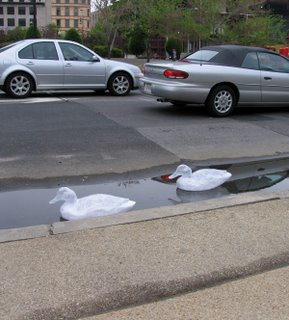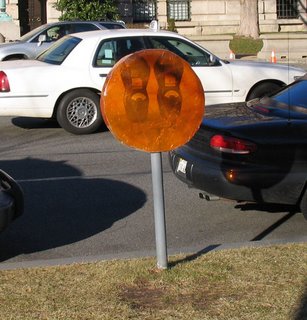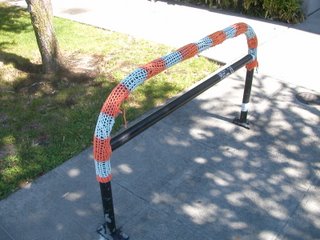 If you haven't thought much about graffiti and its role in public debate, cultural life, and even civic beautification, the current political situation in the United States is making a pretty good case for its value. Public frustration with government is at an all-time high, the U.S. is on the brink of a third concurrent war, and the current administration has controlled the American media better than Reagan, with none of Reagan's finesse. If Reagan's was the Teflon presidency, that of George W. Bush could be remembered by friend and foe alike as the Katamari presidency: ever enlarging, ever strengthening, every potential crisis lending new momentum.
If you haven't thought much about graffiti and its role in public debate, cultural life, and even civic beautification, the current political situation in the United States is making a pretty good case for its value. Public frustration with government is at an all-time high, the U.S. is on the brink of a third concurrent war, and the current administration has controlled the American media better than Reagan, with none of Reagan's finesse. If Reagan's was the Teflon presidency, that of George W. Bush could be remembered by friend and foe alike as the Katamari presidency: ever enlarging, ever strengthening, every potential crisis lending new momentum.
Advertising agency BBDO West recently offered its services pro bono to the city of San Francisco, and chose graffiti cleanup as its Up With People message. For the agency executives it may have seemed like a safe issue. (One of the three advertisements it produced is at left; the others can be viewed here.) But the frustration and anger the agency's outdoor advertising campaign has generated within the graffiti art community has given some of the form's practitioners ("writers") an opportunity to explain their work in both words and images on such websites as the Wooster Collective, which posts photographs of graffiti art from around the world. Graffiti boosters responded to the ad campaign with a series of inspired response images, and the Wooster Collective synthesized the messages of these works by taking the unusual step of responding in writing to BBDO and the mayor's office of San Francisco in a recent text post. The schism the conflict reveals is as transparently class-based as the sick feeling you should be feeling during the current Stanley Steemer Carpet Cleaner commercials where the happy housewife boasts about how "clean" the servicemen are who come to clean the carpets in her spacious and otherwise spotless home. She isn't cruel so much as pathologically insensitive, and her steam-cleaned existence speaks to a dominant culture that runs roughshod over many in its pursuit of narrowly defined goals.
Ironically, BBDO and the community it took on have much in common. Like billboards, wall advertising, bench advertising, posters, and flyers, graffiti art meets you on the street where you live. Depending on its content, it may be designed to elicit shock, anger, amusement, joy, desire, or introspection. But graffiti art was written or drawn on-site by someone, often displaying great skill with spray paint or imagination in setting an incongruous scene into your environment, and is by its nature illicit; while graffiti styles and techniques may be exportable to the gallery, the civic mural, and even the artist's canvas, many writers would agree with my belief that true graffiti is illegal by definition, and that much of the charm of the exported stylistic qualities are borne of guilt by association. In this view, graffiti is a protest against everything every successful ad agency stands for: the commodification of public space, the standardization of the built environment, and the permission-based, central control of communication in the form of visual display, which dystopians and state planners the world over agree is the most powerful way to communicate with large groups of strangers who are busy doing something else - the definition of a modern city.
The political nature of the act itself takes much of the pressure off of writers to supply politically-charged content; the accusation is implicit in the act, and the resulting image can be purely ornamental and still carry the same weight. For the creator, this protest is often so internalized as to feel like a purely natural expression, without malice or anger. As one writer put it in an interview with Art Crimes:
Many people have the urge to write their names places to commemorate being there. People don't get upset when they hear stories of "Kilroy was Here" or kids scratching in Janet + Joe on a tree. But somehow when writing gets associated with the city, and kids from all races and backgrounds get together to express themselves in some rebellious way right in the face of everyone, it gets associated with evil. Then officials feel the need to go over graffiti with plain flat paint. The thing that they don't understand is that they are expressing themselves just as much as we are when we put our name or crew up. Unfortunately they don't have the creativity that we do.
Taking its name from an Italian term for a method of ornamenting architectural plaster or pottery by etching into it -
graffito, "little writing," "little scratching" - the term was adopted to describe the type of graffiti art that emerged in the late 1960s and early 1970s in American cities, and which still constitutes a major strand of street art. In the words of
Ilse Scheepers:
Although the general public criticises graffiti for contributing to the 'ugliness' of an area, graffiti writers as a rule do not write for the public as an audience. They write for themselves, and other writers, engaging in a dialogue with others who they may have never met, who inhabit the same city or visit the same areas.
This is the motivation that most people who have spared a thought for graffiti art can quickly recognize:
These people feel cut off from other channels of communication; and, for some, engenders a curiosity about an otherwise "invisible" class of people who surround them. But there is another major strand of the modern graffiti art community which, while undertaking its project in the same spirit, attempts to communicate with its local community about issues of concern using a wide range of techniques and levels of meaning.
This fact can be attested to by the presence, in cities like San Francisco where graffiti is common, of illegally-painted murals executed with 30 cans of spray paint, dozens of oil paint sticks or markers loaded with artist-mixed inks, which have themselves been "defaced" by simple spray-paint or Sharpie tags. This visual conflict is tangible evidence of not only the competitive and performative nature of graffiti art but also a sign of competing communities at work who do not share a common goal. While simple tagging has its own argument to make as a system of meaning - if there is significance to the statement "Claudius Was Here" etched in a Roman monument, that meaning is only enhanced when the historical context is our own and the message is coded to prevent our understanding it - it is the latter type of expressive, engaging, and challenging street art that primarily interests me.

The anger expressed by the members of the Wooster Collective is largely a product of BBDO and the city of San Francisco's refusal to acknowledge the sociological significance of the former type of graffiti or the intrinsic value of the latter as an art form. And their argument has merit. In a city with a
median income of $60,000 and a
median home value of $750,000, in a nation where protest can be consigned to fenced "free speech zones" and where a programmer just testified to
helping write code at the request of the Speaker of the Florida House that would use electronic voting machines to throw an election, those with alternative opinions have ample opportunity to feel like an outsider. (The best of several response images to the advertisement above is shown at left.) Why, they wonder, can Coke, Wells Fargo, the IRS or the Army inject themselves so easily into our public space, while artists and activists with a variety of critiques must stand on the sidelines or be accused of creating "visual pollution"?
Power has shifted towards dissent with the explosion of the Internet; the most concrete example of this is that through the Wooster Collective,
The Streets Are Saying Things, and other websites, graffiti writers and artists who produce illicit public works can communicate better than ever before. Graffiti writers, producing their work under cover of darkness, once yearned for walls that had visibility but wouldn't be quickly painted over, to maximize locals' exposure to their work before it was removed; now they can write anywhere, take a photograph, and communicate their message with a worldwide audience. Illicit artists made the boldest statements possible in hopes of capturing the attention of a TV news crew to help publicize their work before authorities removed it, or created works so subtle they were rarely noticed; now a photograph of the finished project not only grants them the same exposure, but the work can even be designed with the photograph as the end goal. With the virtual space of the Internet rapidly eclipsing all other forms of visual communication, illicit art now finds itself with the same access to shape-shifting public stage that advertisers enjoyed almost exclusively in the last century.
Read my follow-up post, Visualizing Dissent: Art As Graffiti.



























